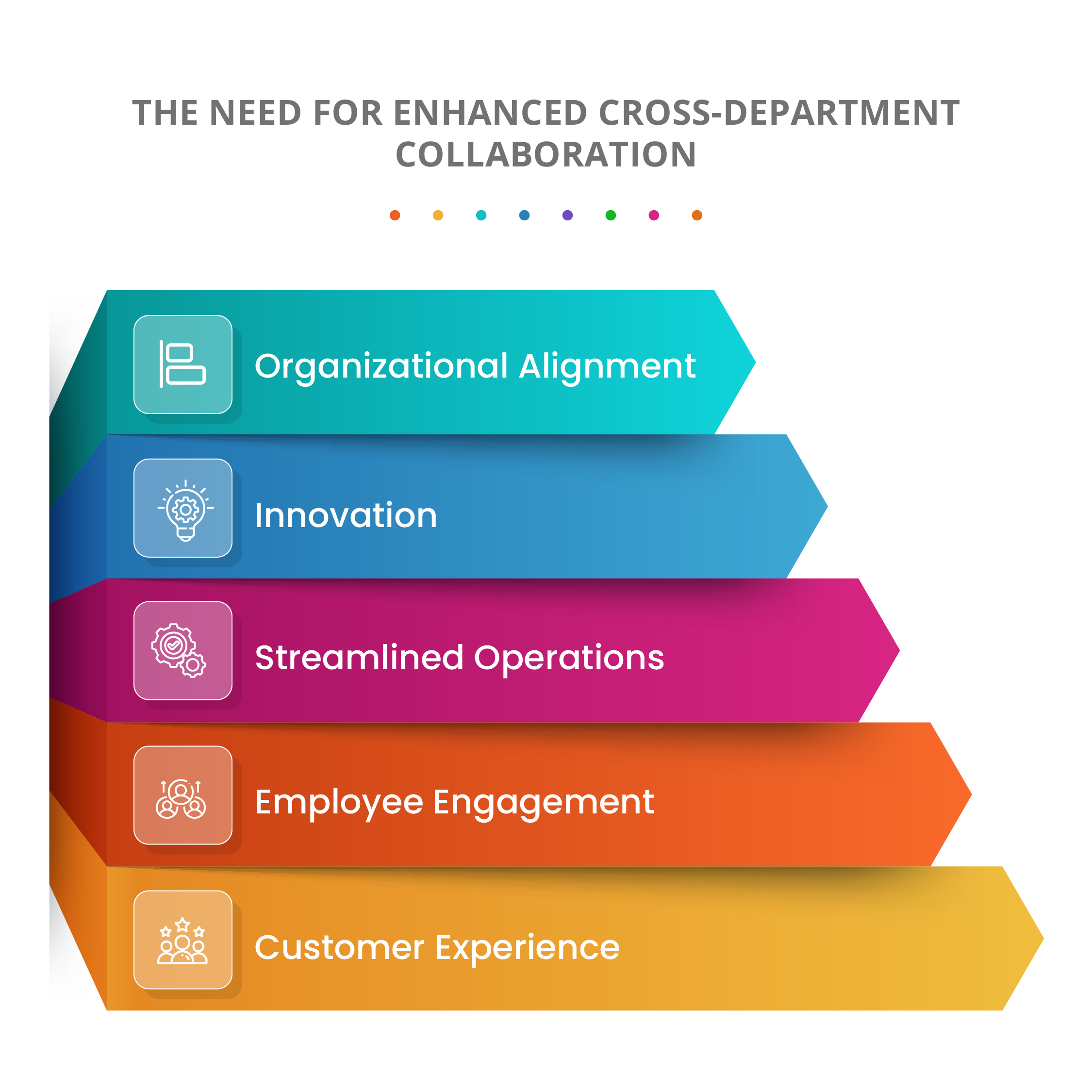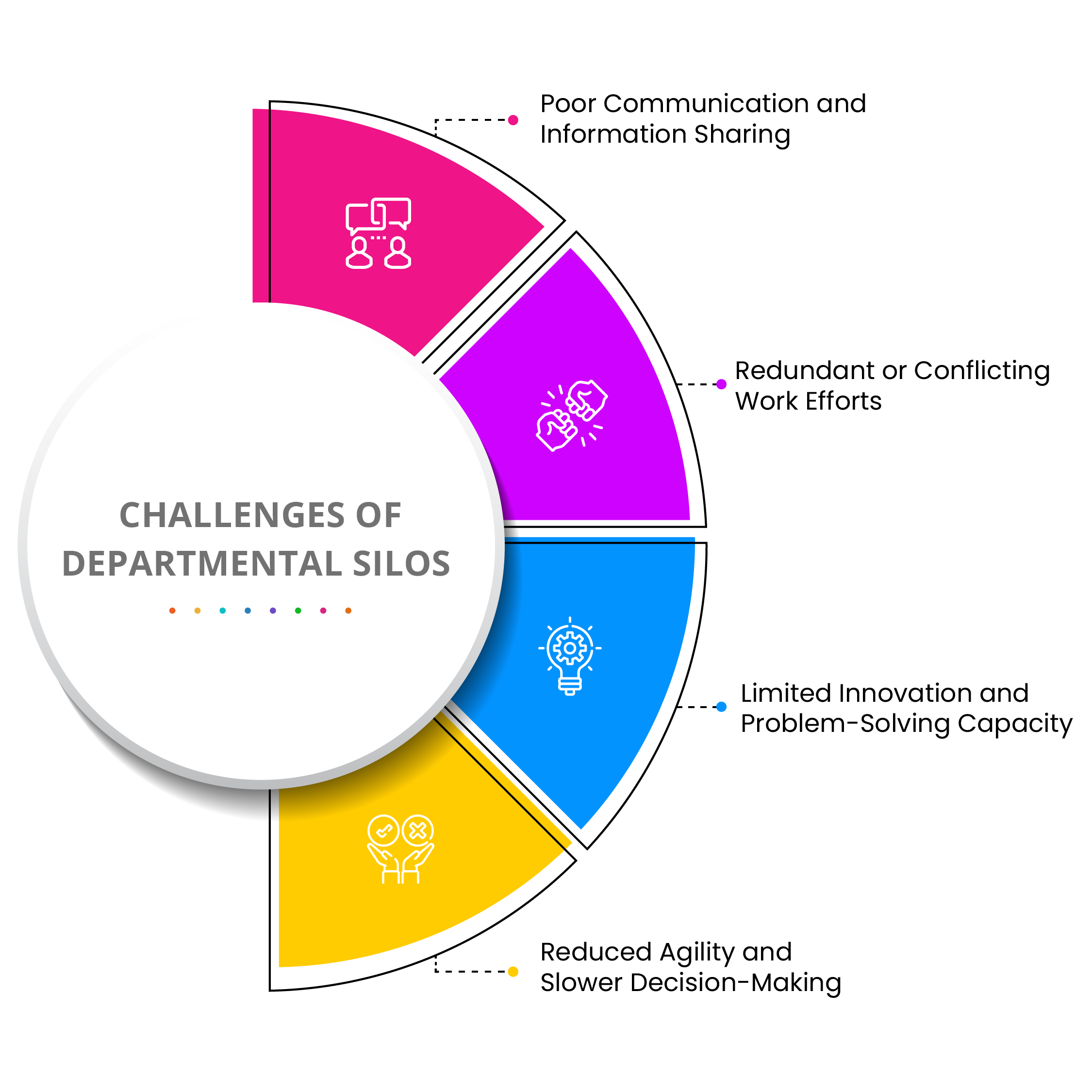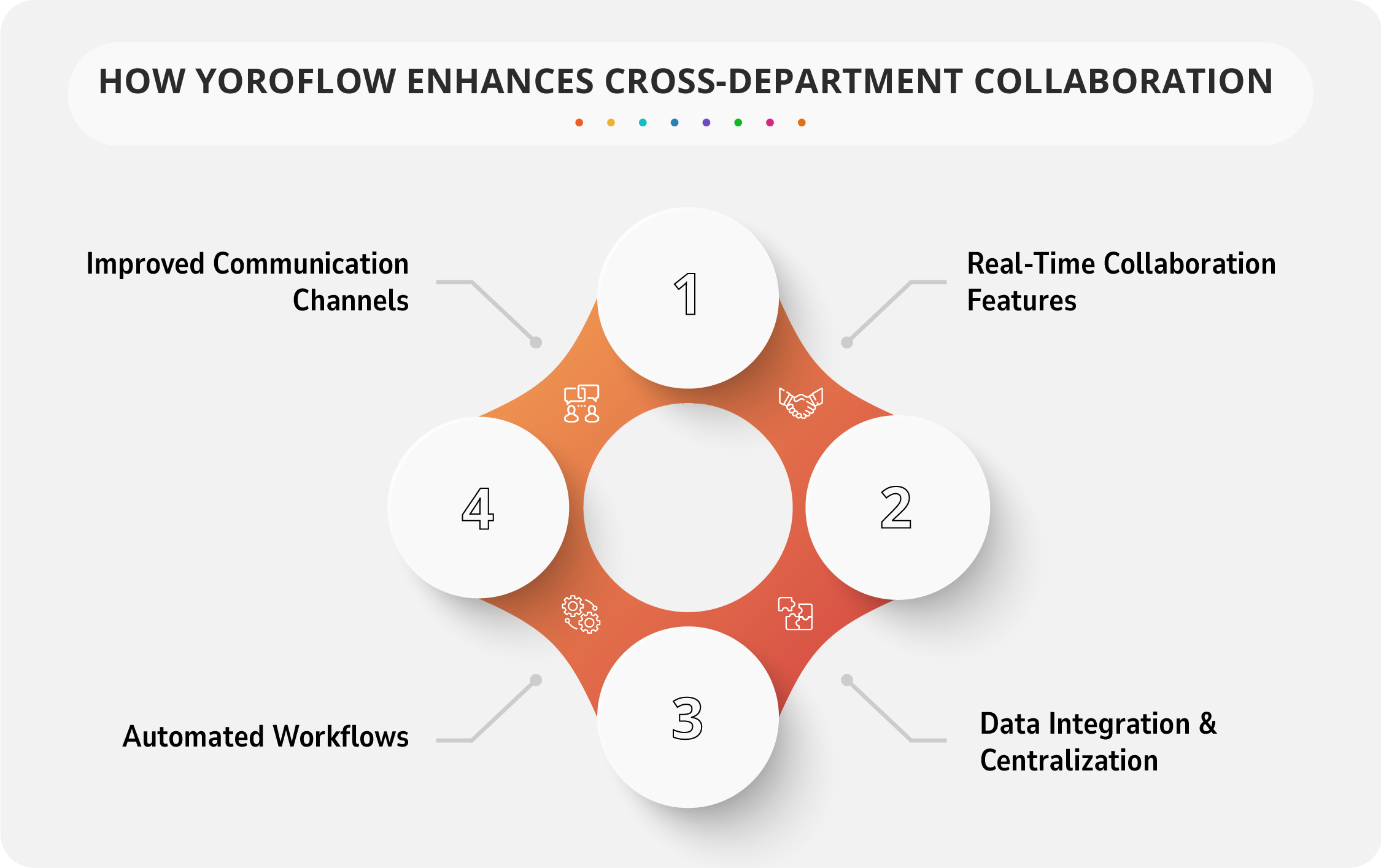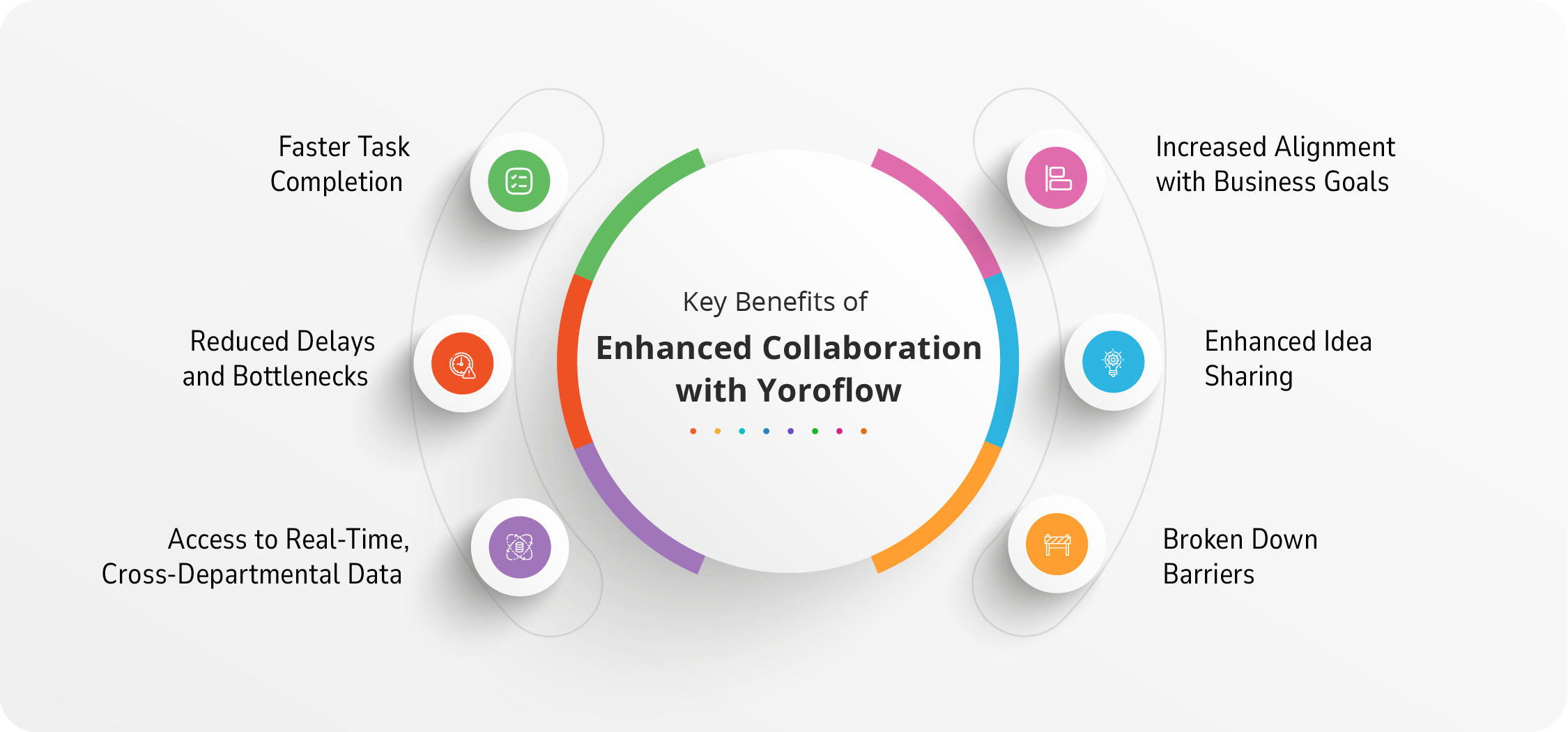Let's see the glimpse below,
- Introduction
- Understanding Departmental Silos
- The Need for Enhanced Cross-Department Collaboration
- Challenges of Departmental Silos
- The Role of Technology in Breaking Silos
- How Yoroflow Enhances Cross-Department Collaboration
- Best Practices for Implementing Yoroflow
- Overcoming Challenges in Cross-Department Collaboration
- Case Study
- Future of Cross-Department Collaboration with Yoroflow
- Embracing Change with Yoroflow
Introduction
In 2024, departmental silos continue to challenge organizations, with 60% of employees feeling isolated, resulting in decreased morale. According to the Harvard Business Review, these silos can waste up to 30% of resources due to redundant efforts. A survey by Asana highlights that nearly 50% of employees believe communication breakdowns hinder productivity. Office workers spend an average of 4 hours and 38 minutes weekly on duplicated tasks, adding up to over 230 hours annually.
This lack of coordination not only strains resources but also stifles creativity, as highlighted by IBM's Global CEO Study, where 72% of CEOs identified inadequate collaboration as a primary obstacle to innovation.
Moreover, the inability to communicate effectively across departments can slow down decision-making processes. A report from Gartner shows that companies with strong collaborative cultures can respond to market shifts 30% faster than those trapped in silos. This agility is vital in today’s competitive landscape, where businesses must remain responsive to customer needs and industry trends.
Understanding Departmental Silos
Departmental silos refer to the phenomenon where different departments or teams within an organization operate in isolation from each other. This isolation can be physical, such as departments being in separate locations, or it can be more structural, where departments have their own distinct goals, processes, and tools, leading to limited interaction and information sharing. These silos often arise due to organizational structure, hierarchy, or even the specialization of tasks within teams. While specialization can be beneficial for efficiency, it can also lead to the development of disconnected “islands” within an organization.
In siloed environments, teams tend to focus on their internal goals without considering the larger organizational objectives. This creates a lack of visibility into how other departments work, their challenges, or the resources they might need. As a result, each department may end up reinventing the wheel or duplicating efforts that are being addressed elsewhere in the company.
The Need for Enhanced Cross-Department Collaboration

Breaking down silos and fostering cross-department collaboration is essential for creating a more agile, innovative, and productive organization. In today’s fast-paced environment, fluid communication across departments is critical for staying competitive.
- Organizational Alignment: Collaboration ensures that all departments work toward common goals, improving coordination and overall efficiency by aligning individual efforts with the broader mission.
- Innovation: Collaborative environments bring together diverse ideas and skills, leading to creative solutions and breakthrough innovations that wouldn't emerge in siloed structures.
- Streamlined Operations: By enabling seamless information sharing, collaboration speeds up decision-making, empowering teams to act swiftly and effectively in a dynamic market.
- Employee Engagement: When employees are involved in cross-functional projects, they feel more connected and motivated, which fosters a sense of community and boosts satisfaction.
- Customer Experience: Cross-department collaboration ensures alignment in delivering exceptional customer service, allowing teams to act on shared insights, leading to faster, more personalized responses.
Challenges of Departmental Silos
Poor Communication and Information Sharing
Departmental silos create barriers that hinder effective communication across teams. This isolation leads to fragmented information, resulting in teams working with outdated or incomplete data. When departments don’t share insights or updates, it becomes difficult to align on goals and strategies, fostering misunderstandings and reducing overall efficiency.
Redundant or Conflicting Work Efforts
When departments operate independently, they may duplicate efforts or pursue conflicting objectives. This redundancy can lead to wasted resources and time, as multiple teams unknowingly tackle the same projects or initiatives. Furthermore, conflicting strategies may confuse employees and disrupt overall organizational coherence.
Limited Innovation and Problem-Solving Capacity
Siloed environments restrict the flow of ideas and insights, stifling creativity and innovation. When diverse perspectives are not brought together, teams may miss out on unique solutions to complex problems. Collaboration across departments is essential for fostering an environment where innovative ideas can emerge and thrive.
Limited Innovation and Problem-Solving Capacity
Effective communication and collaboration are crucial for swift decision-making, especially in fast-paced markets. Silos slow down this process, as information must pass through multiple layers of hierarchy before reaching decision-makers. This lack of agility can result in missed opportunities and an inability to respond effectively to market changes or customer needs.

The Role of Technology in Breaking Silos
Departmental silos refer to the phenomenon where different departments or teams within an organization operate in isolation from each other. This isolation can be physical, such as departments being in separate locations, or it can be more structural, where departments have their own distinct goals, processes, and tools, leading to limited interaction and information sharing. These silos often arise due to organizational structure, hierarchy, or even the specialization of tasks within teams. While specialization can be beneficial for efficiency, it can also lead to the development of disconnected “islands” within an organization.
How Yoroflow Enhances Cross-Department Collaboration

Improved Communication Channels
Yoroflow enhances communication by providing integrated messaging and notification systems, allowing teams to share updates and feedback effortlessly. This ensures that everyone stays informed about project developments, which reduces misunderstandings and promotes clarity across departments.
Automated Workflows
By automating repetitive tasks such as data entry and approval processes, Yoroflow removes friction between departments. This automation streamlines operations, allowing employees to focus on higher-value work rather than administrative duties, thereby increasing overall productivity.
Data Integration & Centralization
Yoroflow centralizes data in a single platform, enhancing transparency and accountability. When all departments access the same up-to-date information, it fosters collaboration and allows teams to track progress easily, helping to align objectives and responsibilities.
Real-Time Collaboration Features
Yoroflow offers real-time collaboration tools, including shared dashboards and document management systems. These features enable teams to work together simultaneously, facilitating instant feedback and updates, which promotes a more cohesive and agile work environment. Overall, Yoroflow provides the necessary tools for breaking down silos and fostering effective cross-department collaboration.
Key Benefits of Enhanced Collaboration with Yoroflow

Faster Task Completion
Yoroflow automates routine and repetitive tasks, allowing teams to focus on high-priority and strategic activities. By creating automated workflows for processes like approvals, notifications, and task assignments, tasks move seamlessly from one team to another without manual intervention. This reduces idle time between steps, accelerates task completion, and ensures that deadlines are met more consistently. For example, automated document routing and approval processes can drastically reduce wait times, allowing projects to progress without unnecessary delays.
Reduced Delays and Bottlenecks
One of the main advantages of automating workflows is the ability to identify and address bottlenecks in real-time. Yoroflow provides visibility into where tasks are in the process, enabling teams to pinpoint delays and take corrective action immediately. By keeping workflows moving smoothly across departments, it minimizes the risk of miscommunication or missed handoffs that often cause delays. This leads to more streamlined processes, quicker project completion, and higher levels of operational efficiency.
Access to Real-Time, Cross-Departmental Data
In organizations where data is siloed, decision-makers often rely on outdated or incomplete information, leading to suboptimal decisions. Yoroflow integrates with various tools and systems, allowing access to real-time data from across departments. This ensures that everyone has access to up-to-date, accurate information when making decisions. For example, a sales team can view real-time inventory data, or HR can monitor hiring progress instantly, leading to more informed decisions that align with current business conditions.
Increased Alignment with Business Goals
By providing a centralized platform for tracking and managing tasks, Yoroflow ensures that all departments work towards common objectives. Cross-departmental collaboration leads to better alignment with strategic business goals because teams can monitor how their work fits into the larger organizational framework. With Yoroflow, leadership can set clear priorities, track progress, and make adjustments in real-time to ensure that departments remain aligned and focused on delivering value to the business.
Enhanced Idea Sharing
Breaking down silos allows teams from different departments to collaborate more effectively, fostering an environment of innovation. When employees from various teams work together, they can share diverse perspectives and ideas that lead to creative solutions to business challenges. Yoroflow facilitates this by providing collaborative tools that encourage cross-team communication, making it easy for employees to collaborate on shared projects, regardless of department or location. This results in a more dynamic and innovative workplace.
Broken Down Barriers
Silos often lead to a sense of isolation among teams, where employees may feel disconnected from the broader goals of the organization. Yoroflow’s collaborative platform enhances transparency and communication, allowing employees to see how their work contributes to overall company success. When employees have clear visibility into the progress of projects and can easily collaborate with peers across departments, it boosts morale, engagement, and a sense of purpose. This increased engagement often leads to higher job satisfaction and reduced turnover, as employees feel more connected to their teams and the organization as a whole.
Best Practices for Implementing Yoroflow
To ensure the successful adoption of Yoroflow across departments, it’s essential to begin by aligning leadership and team objectives. This alignment fosters a unified vision and signals commitment from management, which is crucial for engagement. Implementing effective change management strategies is also vital for securing team buy-in. Early engagement with employees helps them understand how Yoroflow can enhance their workflows, while comprehensive training and resources equip them to use the platform effectively.
Additionally, regular feedback sessions provide a channel for addressing concerns and adapting strategies, ultimately fostering a culture of collaboration and continuous improvement. This approach not only enhances the likelihood of a smooth transition but also empowers teams to leverage Yoroflow’s capabilities fully.
Overcoming Challenges in Cross-Department Collaboration
Addressing Resistance to Change
Challenge :
One of the most common obstacles to cross-department collaboration is resistance to change. Employees may be hesitant to adopt new collaboration tools or processes due to concerns over increased workload, fear of the unknown, or potential disruption to their current ways of working. This resistance can slow down adoption and negatively impact the success of new initiatives aimed at improving collaboration.
Solution :
- Clear Communication of Benefits: To address resistance, it’s crucial to communicate the benefits of enhanced collaboration clearly. Leadership must explain how tools like Yoroflow can streamline workflows, reduce manual tasks, and enhance productivity across teams. Demonstrating the value of these improvements to both individuals and the organization as a whole can help shift mindsets.
- Gradual Implementation: Implementing new tools gradually, rather than all at once, allows employees to adapt without feeling overwhelmed. Starting with a pilot program in a single department and expanding gradually helps ease the transition and gives teams time to get comfortable with new processes.
- Training and Support: Comprehensive training programs that focus on practical, real-world use cases can help employees see the value of cross-departmental collaboration. Additionally, offering continuous support through webinars, workshops, and dedicated help desks can help ease concerns and build confidence in the new tools and processes.
Ensuring Seamless Integration with Existing Systems
Challenge :
Another significant challenge in fostering cross-department collaboration is integrating new tools with existing systems. Many organizations rely on legacy software for core functions like CRM, ERP, project management, or communication. If new collaboration platforms don’t integrate seamlessly with these systems, it can lead to inefficiencies, data silos, and frustration among employees who are forced to switch between multiple platforms.
Solution :
- Flexible Integration Capabilities: Tools like Yoroflow offer flexible integration capabilities, allowing businesses to connect their existing software systems (e.g., CRMs, project management tools, and communication platforms) with the new collaboration platform. This ensures that employees don’t need to duplicate efforts or manage information across multiple systems, reducing friction in adoption.
- API-Driven Customization: Custom API integrations can be used to build a unified digital ecosystem where all key tools communicate effectively. Yoroflow’s ability to integrate with a wide range of business applications allows for custom workflows that suit each department's unique needs.
- Data Migration Planning: A well-planned data migration strategy is essential for seamless integration. This involves mapping out how existing data will flow into the new system, ensuring that all critical information remains accessible and accurate, preventing disruptions during the transition period.
Building a Culture of Collaboration
Challenge :
Even with the right tools in place, fostering true cross-department collaboration requires a cultural shift within the organization. Many departments operate in silos, with limited communication or visibility into the work of other teams. This lack of collaboration can lead to inefficiencies, misaligned goals, and reduced innovation. Changing this mindset is crucial to the success of cross-functional initiatives.
Solution :
- Leadership Buy-In and Example Setting: Leadership plays a key role in fostering a collaborative culture. By championing cross-department collaboration and leading by example, executives and managers can encourage employees to break down barriers between teams. When leadership actively participates in collaborative efforts and emphasizes their importance, it sets the tone for the entire organization.
- Cross-Department Initiatives and Teamwork: To build a culture of collaboration, organizations should establish cross-functional teams for key projects. This encourages employees from different departments to work together, share insights, and develop a greater appreciation for each other’s roles. Yoroflow supports this by providing centralized communication channels and tools that enable easy collaboration across teams.
- Recognition and Reward Systems: Recognizing and rewarding collaborative behavior can incentivize employees to embrace cross-departmental efforts. Whether through team-based rewards, acknowledgment in company meetings, or even formal recognition programs, creating positive reinforcement for collaboration fosters an environment where teamwork is encouraged and valued.
- Regular Feedback and Adaptation: A culture of collaboration isn’t built overnight; it requires ongoing effort and adaptation. Establishing regular feedback mechanisms, such as surveys or town hall meetings, allows employees to voice their experiences and suggest improvements. By acting on this feedback, companies can refine their processes to better support cross-department collaboration.
Case Study
Streamlining Marketing and Sales Collaboration
Challenge :
In many organizations, marketing and sales teams operate in silos, with limited communication and misaligned goals. Marketing generates leads, but sales teams often lack visibility into campaign performance or lead quality, leading to inefficiencies in lead nurturing and conversion efforts.
Solution :
Yoroflow was implemented to create a seamless, integrated workflow between marketing and sales. The platform allowed the marketing team to automate lead generation processes and share real-time insights with the sales team. By integrating CRM and marketing automation tools within Yoroflow, marketing was able to pass high-quality leads directly into the sales pipeline, complete with lead scoring and detailed engagement histories.
Results :
- Real-Time Campaign Insights: Both marketing and sales had access to real-time data on lead engagement, allowing sales teams to tailor their outreach based on campaign interactions.
- Better Alignment: Marketing and sales teams were more aligned on shared goals, with a clear view of how each campaign contributed to revenue targets. This enhanced collaboration led to increased lead-to-conversion ratios and better overall performance.
Enhancing Project Management Across IT and Operations
Challenge :
In a large organization, the IT and operations departments struggled with project coordination. IT was responsible for deploying new systems, while operations needed to manage day-to-day tasks, but both teams lacked visibility into each other’s timelines and project dependencies. This often led to miscommunications, missed deadlines, and delays in project execution.
Solution :
Yoroflow was implemented to create a unified project management workflow that integrated the IT and operations teams. Both departments were able to use Yoroflow to map out project timelines, dependencies, and milestones, with real-time updates shared across teams. Automated task assignments and notifications kept both IT and operations teams informed about project status, upcoming tasks, and potential bottlenecks.
Results :
- Better Project Transparency: Yoroflow provided real-time visibility into project progress for both IT and operations, reducing miscommunication and ensuring that all stakeholders were informed of project milestones and deadlines.
- Faster Issue Resolution: Automated notifications alerted teams to potential delays or blockers, enabling quicker intervention and problem-solving.
- Increased Efficiency: By synchronizing their workflows, IT and operations were able to execute projects more efficiently, reducing project timelines and improving the success rate of system deployments and operational rollouts.
- Improved Accountability: With clear task assignments and automated progress tracking, both teams were held accountable for their respective tasks, leading to smoother project execution and improved overall performance.
Future of Cross-Department Collaboration with Yoroflow
As technology continues to advance, Yoroflow is poised to integrate sophisticated features such as AI-driven insights and improved integration capabilities. These enhancements will enable organizations to analyze workflows and optimize performance more effectively. To prepare for this tech-driven future, companies should invest in comprehensive training programs that empower employees to utilize these new tools. Additionally, fostering a culture of continuous improvement will encourage teams to adapt quickly and leverage the full potential of Yoroflow’s evolving features, ultimately enhancing cross-department collaboration.
Embracing Change with Yoroflow
Breaking down departmental silos is crucial for business success, as it fosters enhanced communication, collaboration, and innovation. Yoroflow plays a critical role in facilitating seamless collaboration across departments by providing a centralized platform that enhances communication, aligns goals, and supports cross-functional teamwork. Organizations that successfully implement collaboration technologies like Yoroflow can expect to see tangible benefits. For instance, a survey report from Together Mentoring Software says, effective communication within organizations can lead to a 25% increase in productivity, and adopting collaborative tools can significantly improve employee engagement and job satisfaction.
As we look to the future, the integration of technologies like AI-driven insights within Yoroflow will further enhance collaboration, making it easier for teams to share information and innovate together. By embracing a culture that prioritizes transparency and teamwork, organizations can break down silos, improve performance, and ultimately achieve greater success in a rapidly evolving marketplace.